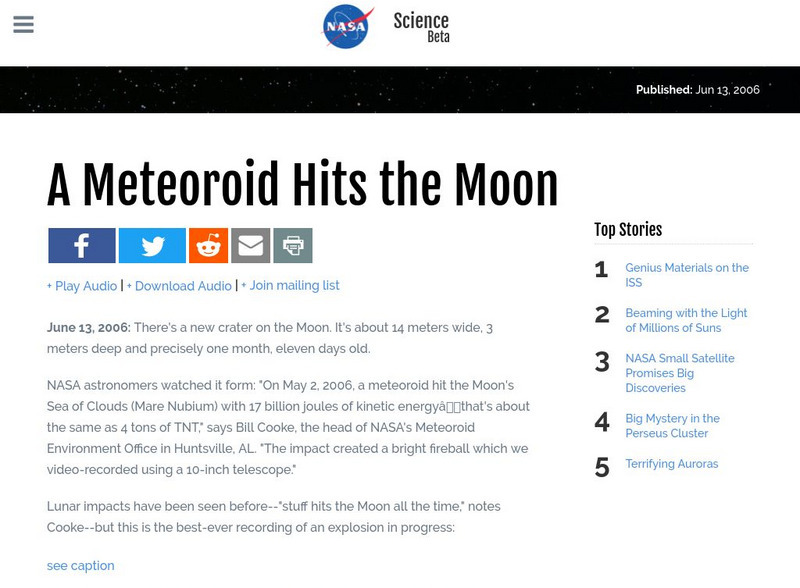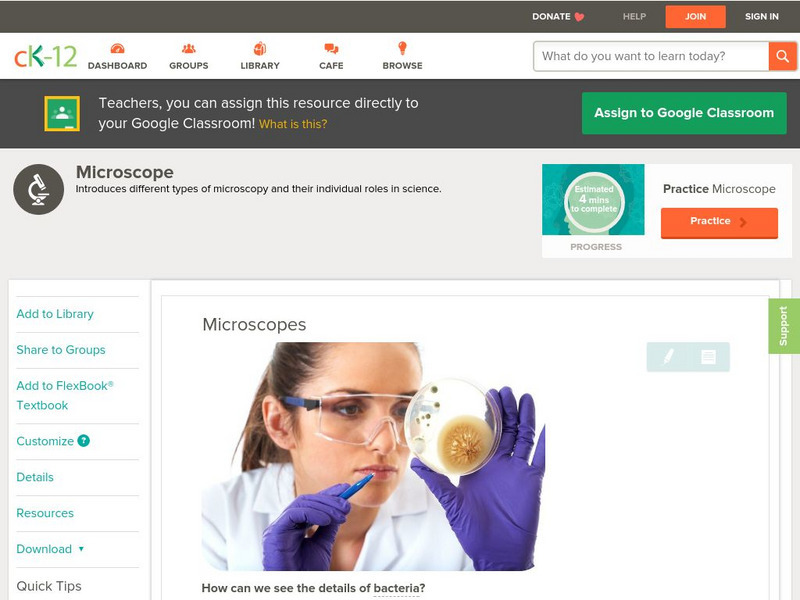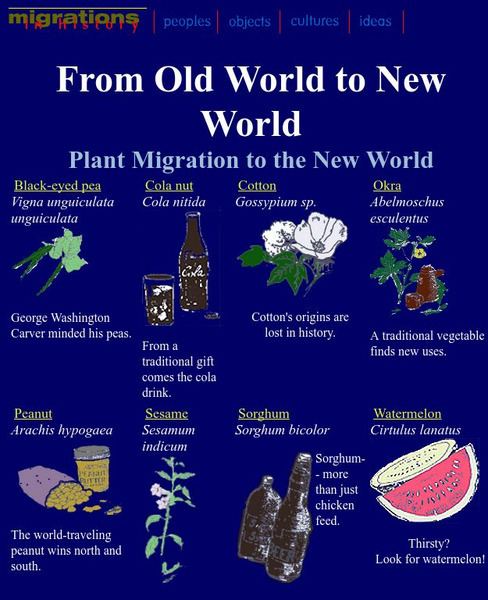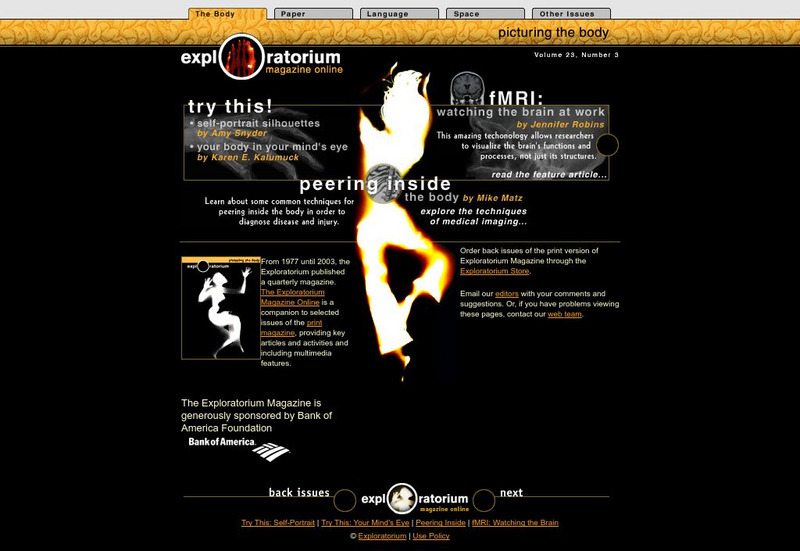Other
Learning Together: Do You Know About Anatomy?
Students can test their knowledge of the human body with these interactive games. Identify the parts of the body by dragging the terms to the appropriate boxes. Quizzes check knowledge on the skeleton, skull, digestive system,...
Texas Instruments
Texas Instruments: Finding the Shortest Path
Students discover the shortest distance light travels from an object to the human eye, as the light from the object reflects off a single mirror. In the process they learn about reflection in a line, congruent angles, angle bisectors,...
TED Talks
Ted: Ted Ed: Visualizing Hidden Worlds Inside Your Body
How do we see things too small to be detected by the human eye? What about things inside our own bodies? Dee Breger uses a scanning electron microscope to give us a glimpse of images including blood clots, thyroid glands, and lungs with...
NASA
Nasa: A Meteoroid Hits the Moon
On May 2, 2006, a meteoroid hit the moon with a force equivalent to four tons of TNT. The event was captured on a 10-inch telescope equipped with a video camera. The video was then played in slow motion in order to be visible by the...
TED Talks
Ted: Ted Ed: How Do Animals See in the Dark?
To human eyes, the world at night is a formless canvas of grey. Many nocturnal animals, on the other hand, experience a rich and varied world, bursting with details, shapes, and colors.Anna Stockl uncovers the science behind night...
CK-12 Foundation
Ck 12: Life Science: Microscopes
[Free Registration/Login may be required to access all resource tools.] A microscope is a tool used to make things that are too small to be seen by the human eye look bigger. Before microscopes were invented in 1595, the smallest things...
PBS
Pbs Learning Media: Nova: Earth System Science Share Favorite: Collection
NOVA's Earth system science collection highlights important Earth processes normally invisible to the human eye. The standards-based media resources below expose the intricate web of forces that sustain life on Earth, allowing educators...
Curated OER
Altlas of European Values: Eyes of the World
Special-effects photograph of a human face overlaid with a map of the world..
Greek Gods
Greek Gods: Monsters: Cyclopes
Learn more about the Cyclopes, mythological giants with only one round eye in their forehead. See why they only have one eye.
PBS
Pbs Kids Design Squad: Take a Look
See how a new mobile phone technology is helping people receive basic eye exams.
PBS
Pbs Teachers: The Intimate Machine: Making Faces
Investigate the scientific innovation of giving computers facial features and expressions to improve human-computer interactions. Construct model faces that communicate six emotions using facial features including the mouth, eyes, and...
National Endowment for the Humanities
Neh: Edsit Ement: Childhood Through the Looking Glass
The objective of this site is to explore the visition of childhood through Lewis Caroll's eyes. This site features learning objectives and lesson plans. Don't miss out.
University of Washington
The Senses
This site has a collection of learning activities, games, experiments, and lesson plans on the five senses. Organized by grade level and topic, this site is packed with an assortment of interactive and engaging activities, that would...
Read Works
Read Works: Double Vision
[Free Registration/Login Required] An informational text about how 3-D televisions work. A question sheet is available to help students build skills in reading comprehension.
NASA
Electromagnetic Spectrum: Ultraviolet Waves
Ultraviolet (UV) light has shorter wavelengths than visible light. Though these waves are invisible to the human eye, some insects can see them. The specific wavelength values are given. Uses and applications of these waves are explained.
NOAA
Noaa: Seeing Things Differently Using Polarization [Pdf]
Discover how polarizing filters can make certain objects more visible to the human eye.
PBS
Pbs Teachers: Blind Spot
Discover the blind spot in the human eye with a simple experiment, then alter the experiment to discover the size and shape of your blind spot.
University of Washington
Neuroscience for Kids: Reflexes
Site provides interactive activities to use in the classroom to test one's reflexes. Also includes more reaction time experiments as well as links to more fun activities.
Other
Marine Biological Laboratory: Why Study Marine Organisms for Biomedical Research
Descriptions of various research projects using marine organisms that have direct impact on medical research. The resource has a perspective on how medicine makes progress.
Smithsonian Institution
Smithsonian Education: From Old World to New World
Plants have migrated around the world just like people. This site explains how several African plants and food crops made their way into American life.
Curated OER
Kids Health: My Body
For elementary school children, this page presents information about lungs, muscles, digestive system, teeth, skin, tongue, hair, heart, and more.
Curated OER
Image From the Human Face of War
In-depth look at World War I. Includes summaries of the war years; sound clips of eye-witness accounts; virtual tours of trenches on the Western Front; maps; articles and overviews; and similar resources.
Khan Academy
Khan Academy: Decoding Anglo Saxon Art
In Anglo-Saxon art there is always more than meets the eye. The dense animal patterns that cover many Anglo-Saxon objects are not just pretty decoration; they have multi-layered symbolic meanings and tell stories. View examples of their...
Exploratorium
Exploratorium: Picturing the Body
An online version of articles and activities from the Exploratorium Magazine, Vol. 23, No. 3. This issue looked at how we are able to examine the inside of the human body, what kinds of technology are used, and how each of them is used...
Other popular searches
- The Human Eye
- Human Eye Powerpoint
- Drawing the Human Eye
- Human Eye Diagrams
- Parts of the Human Eye
- Biology Human Eye
- Label the Human Eye
- Human Eye Function
- Human Eye 5th Grade
- Human Eyesight
- Anatomy of the Human Eye
- Human Eye Reproducibles


















